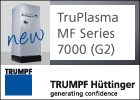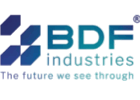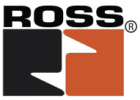Those who outsource high-quality laminated safety glass (LSG) and special products from the autoclave operation and manufacture them with "LamiPress" machine technology work more flexibly, faster and achieve the best LSG quality. Depending on the automation degree, between 50 and 750 square metres of laminated safety glass can be laminated by just two to four employees per shift, with an energy input of less than 10 kW/h per square metre of laminated safety glass. In contrast to the process in the autoclave, which often takes more than six hours, the cycle time in the LamiPress is only (from) 45 minutes. No post-processing of the laminated safety glass edges is necessary, even with complex geometries or drill holes. The LamiPress is also interesting for newcomers: In-house LSG production increases the depth of production - this shortens transport routes, reduces the company's CO2 footprint and increases added value.
Fotoverbundglas Marl GmbH, founded in 2007 by Michael Muschiol, was one of the first companies to print on PVB films and primarily produced customised and high-quality finished individual items. However, the machine technology available at the time was suboptimal: autoclaving individual items or small series meant long delivery times and high costs, while conventional autoclave-free lamination led to quality problems and high failure rates. This is why the resourceful engineer developed his own lamination technology, which has been patented since 2010: the "LamiPress". Today, mechanical engineering is the main business of the family-run company, with 19 machines already in operation internationally, including at some of the "big players" in the flat glass industry. "The reason for the success of our still technically unique solution is the flexibility that arises in production when small quantities, special geometries or complex structures are transferred to the LamiPress," says Alexander Muschiol, son of the founder and engineer at the company. "This relieves the autoclave, which can be utilised with large series, while the LamiPress, with its significantly smaller process space, produces the particularly high-quality batch 1 glass, special formats, laminates with tempered or toughened glass, special coatings and PVB or SGP films faster and more energy-efficiently. This saves a lot of time and energy and reduces the CO2 footprint of our own production." LamiPress is the only alternative process worldwide for the production of laminates with PVB and SGP films that has been successfully tested and extensively certified for a wide range of laminated safety glass products. In the course of many years of co-operation with Kuraray (Trosifol and Sentryglas films) and Eastman (Saflex and Vanceva films), the overpressure process of the systems has been perfected and is now the most reliable process on the market. Even special films with bird protection properties, switchable films, GIPV modules or vacuum glass with PVB and Sentryglas films can be laminated.
Modular design allows for future expansion
Muschiol and his engineers are also happy to plan and design customised systems based on the product mix, hall planning and requirements. Alexander Muschiol reveals: "Our smallest system is in use at the Technical University of Darmstadt, where it is used for research and development projects with small series. The largest system to date is located in Lithuania at Glassbel - where multilayer laminates up to a format of 3 x 8 metres are produced. However, we also have plans for 4 x 20 metres." There are also series models: the smallest variant is the "High Value" solution. In this rotary version with a usable size of 3.21 x 2.55 metres, up to 50 square metres of high-quality laminated safety glass can be produced per shift, for example as a supplement to an existing autoclave line. This means that special products and small batch sizes can be discharged into the LamiPress before pre-compounding, which also guarantees a failure rate of less than one per cent. This optimises the process flow on the VSG line and increases the capacity on the base line by up to 30 percent. The second variant is the "Everybodys`Autoclave" with a usable size of 4 x 3 metres and an output of 100 square metres per shift. Here, the glass packs are fed via the so-called "LamiStore". The third solution, "Max. output", produces up to 250 square metres per shift in a fully automated process in the "LamiDoublePress" feeder with usable dimensions of 6 x 3.21 metres. Intelligent software with hundreds of pre-stored configurations (glass thicknesses, structures, film types, etc.) ensures maximum process reliability, easy-to-control production and perfect results.
























